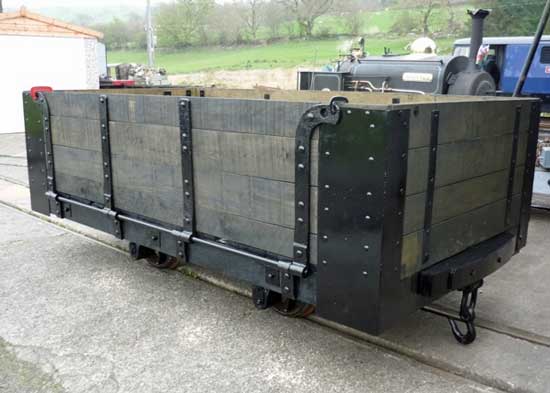May 2015 Update
 After all the excitement that took place in April surrounding Winifred and her triumphant return to service, it might be thought that May would be a quiet month. Not a bit of it! The railway has been breaking records again, and we are proud to announce that passenger figures were up by 10% over May last year, with café/shop receipts up by 31%. Indeed, the café/shop broke all-time records on both Sunday 24th May and again on the Bank Holiday 25th. The locally sourced ice cream, mentioned last month, is continuing to sell very well, and the range of cakes is proving a major distraction as well. The Bala Buzz is affecting everyone.
After all the excitement that took place in April surrounding Winifred and her triumphant return to service, it might be thought that May would be a quiet month. Not a bit of it! The railway has been breaking records again, and we are proud to announce that passenger figures were up by 10% over May last year, with café/shop receipts up by 31%. Indeed, the café/shop broke all-time records on both Sunday 24th May and again on the Bank Holiday 25th. The locally sourced ice cream, mentioned last month, is continuing to sell very well, and the range of cakes is proving a major distraction as well. The Bala Buzz is affecting everyone.
Over the same Bank Holiday period, the Alice weekend took place, where our Hunslet of that name proudly wore her ‘face’, as seen in the Little Welsh Engine books written and illustrated so beautifully by Pauline Hazelwood. This event proved very popular, and the author was on hand throughout the weekend to sign books for young and old alike.

Carriage & Wagon
We combine the news of progress this month as there have been some well-earned holidays. David Hale reports on the Penrhyn Coach Project; “A start has been made on the ten window linings. These are being made from Sapele (a West African hardwood from the Mahogany family). The interior of the carriage will be faced with mahogany plywood, so the whole interior will be a matching red/brown colour, just like the original”.
The Penrhyn Coal Wagon is now completed, as the accompanying photo shows and, indeed, speaks for itself. This is quite an achievement in view of the restricted space currently available for access, as well as the amount of Welsh ‘liquid sunshine’ which has hampered progress from time to time.

The team’s attention will now turn to the other ‘bolster’ wagon, (you may recall that the first was completed a while back), and when finished, a large tree or three will be sourced to show for what they were intended.
Locomotives
The remedial work on the boiler of Holy War is going well, Alice and Maid Marian continue to enchant visitors and crews alike, and Winifred is enjoying her new life, as well as having some small adjustments and improvements.
But we have a new arrival at Llanuwchllyn, a Wickham Trolley, in very good working order, and the owner’s wish is that it (she?) will be of great use to the Wednesday Gang as a more convenient vehicle in which to patrol the line and deal with routine maintenance.

This Wickham Trolley is number 10943, and was ordered on the 15th August 1975 by the Director of Engineering and Planning Services for Southend on Sea Council, for use on the 3ft 6” gauge pier railway, reportedly for use by the RNLI lifeboat crews. It was supplied by D. Wickham & Co. Ltd. of Ware, Hertfordshire, on the 9th February, 1976.
After years of useful service at Southend, it was sold to the Brecon Mountain Railway in 1983, and while there, was converted to two foot gauge. The trolley remained at Brecon until purchased privately and moved to the BLR on the 27th April this year.
It is powered by a 4-cylinder Ford type 2262E low compression engine of 1.3 litres, possibly an early non-crossflow-head version of the famous Kent series. It is of note that Ford’s engine type numbering can cause confusion, as the cubic capacity of Ford’s first Zephyr/Zodiac 6-cylinder engines from the early 1950s was 2262cc, but the motor in this trolley is definitely NOT a Zephyr unit. The trolley features a four speed gearbox in conjunction with a separate forward/backward transmission, and it is interesting to note that the sales leaflet of the time indicates a top speed of 55 mph, in either direction!

And finally…… ‘Our’ Wickham Trolley also comes with a single-axle trailer, which will be of use when moving extra equipment around. The use of single axle trailers was rare in the UK, but not so in Europe, particularly rural France. Many provincial narrow gauge lines, usually metre gauge, but sometimes narrower, regularly used them before and immediately after WW2 for moving freight and produce when attached behind diesel railcars. The most notable user of this type of rail trailer was the Chemin de Fer de la Lozere in the southern Massif part of France, the line running from Florac to Ste Cecile d’Andorge.

